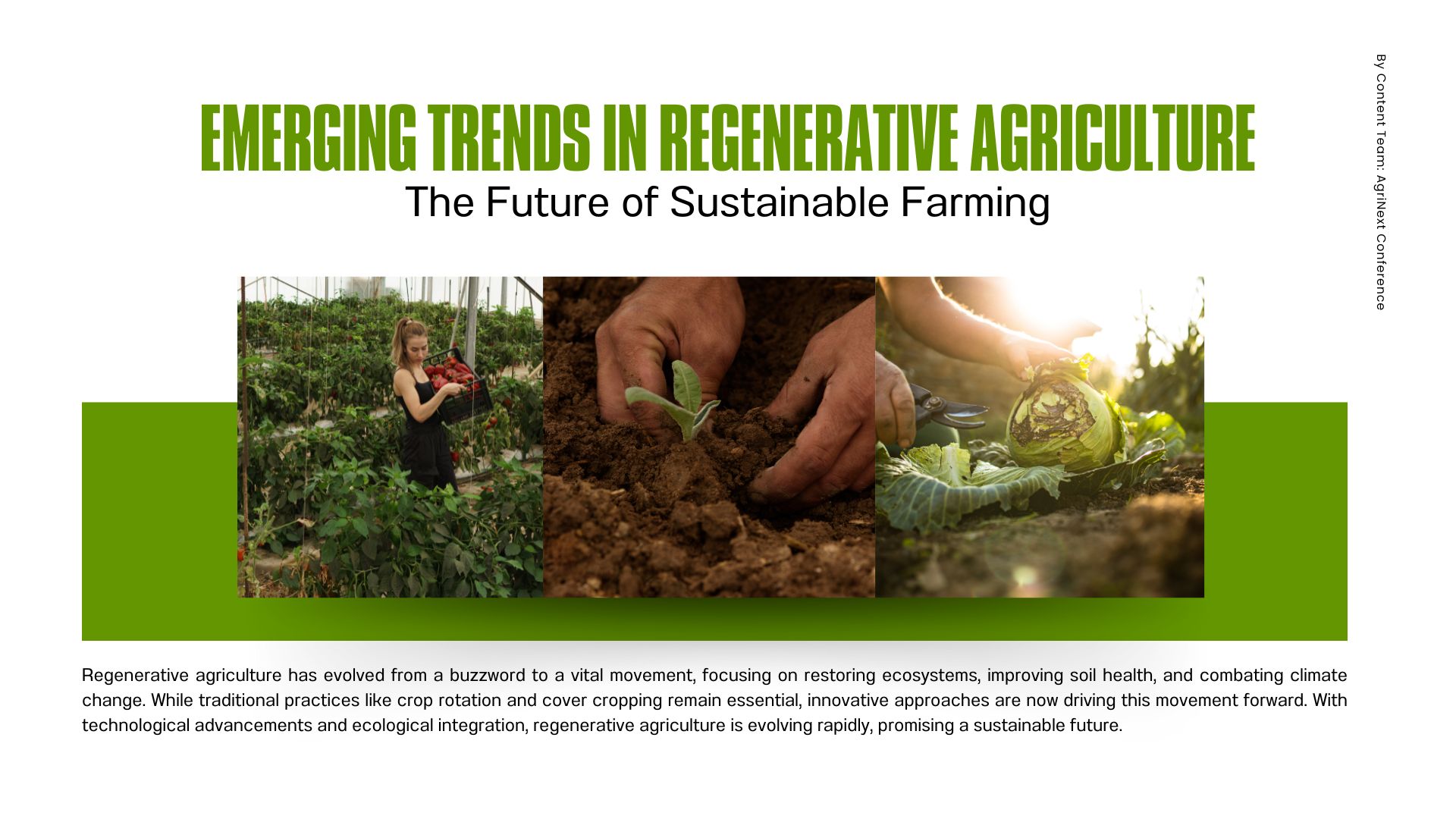
Introduction
Regenerative agriculture has evolved from a buzzword to a vital movement, focusing on restoring ecosystems, improving soil health, and combating climate change. While traditional practices like crop rotation and cover cropping remain essential, innovative approaches are now driving this movement forward. With technological advancements and ecological integration, regenerative agriculture is evolving rapidly, promising a sustainable future.
Case Study: Syntropic Farming, Brazil
Syntropic farming, pioneered by Swiss farmer Ernst Götsch, is an emerging trend that mimics natural ecosystems by combining crops, trees, and animals to create resilient agricultural systems. In Brazil, syntropic farming has restored degraded land in the Amazon and Cerrado regions. Using mixed planting strategies, enhancing organic matter, and reducing external inputs, farmers have improved yields and ecosystem vitality, showcasing how regenerative agroecology can support food production and environmental restoration.
Emerging Trends in Regenerative Agriculture
1. Regenerative Agroecology
Regenerative agroecology combines indigenous knowledge with modern science to create self-sustaining food systems. The FAO’s 10 Elements of Agroecology framework guides countries in implementing transformative changes, such as diversifying crops and recycling resources. This trend promotes soil regeneration, climate resilience, and biodiversity restoration.
For example, The Bonn Challenge, launched in 2011, aims to restore 350 million hectares of degraded land by 2030 using Forest Landscape Restoration (FLR). Ethiopia‘s success with agroecological practices showcases the impact of such global restoration efforts.
2. Carbon Farming as a Revenue Stream
Carbon farming is now seen as profitable, with farmers earning through carbon credits by adopting practices like agroforestry and no-till farming. Platforms like Indigo Ag help farmers connect to carbon markets, turning sustainability into a revenue stream while contributing to climate mitigation.
3. Regenerative Aquaculture
As pressure on oceans and freshwater ecosystems grows, regenerative aquaculture is emerging as a solution for sustainable seafood production. Regenerative aquaculture is making Sustainable seafood production possible, with species like kelp and oysters cleaning water and restoring marine ecosystems.
GreenWave’s innovative ocean farming model combines seaweed and shellfish farming to enhance biodiversity, capture carbon, and promote ecosystem services, offering a promising solution for a more sustainable seafood production.
4. Bio-Intensive Micro Farming: A Solution for Urban Food Systems
Bio-intensive micro farming is gaining popularity in urban areas, where space is limited but demand for fresh, local food is high. This approach focuses on maximizing production on small plots, using techniques such as intercropping, companion planting, and deep soil preparation. Bio-intensive farming is not only productive but also enhances soil health by promoting biodiversity and reducing the need for synthetic inputs.
Urban farmers in cities like New York are demonstrating its potential in local food systems.
Curtis Stone’s Urban Farmer in Canada is a small-scale, high-yield farm that utilizes bio-intensive methods to grow a wide variety of crops, demonstrating the effectiveness of this approach.
5. Perennial Grains and Crops
Traditional grain farming typically requires replanting each year, which leads to soil erosion and degradation. Perennial crops like Kernza reduce soil erosion and sequester carbon, offering a sustainable alternative to traditional grain farming. Researchers at The Land Institute have demonstrated how these crops improve soil health and biodiversity while reducing inputs.
6. Rewilding Farmland: A New Frontier in Sustainable Agriculture
Rewilding farmland allows ecosystems to regenerate by setting aside land for native plants and wildlife. Rewilding farmland not only boosts biodiversity but also enhances critical ecosystem services, such as water filtration and soil health. By setting aside land for natural regeneration, projects like
The Knepp Estate in the UK shows how allowing nature to reclaim portions of the land can lead to thriving ecosystems and sustainable farming practices.
7. Decentralized Regenerative Cooperatives
Small farms are coming together to form cooperatives, allowing them to share resources, knowledge, and market access. These decentralized networks of regenerative farmers are gaining traction as a way for small-scale operations to compete with industrial agriculture while staying true to regenerative principles.
Cooperatives like La Via Campesina, a global movement of peasant farmers, exemplify how decentralized networks can empower farmers through shared access to tools, markets, and support systems, creating resilient and sustainable food systems.
8. The Power of Fungi in Soil Regeneration
Mycorrhizal fungi form vital symbiotic relationships with plant roots, revolutionizing soil health. By partnering with these fungi, plants absorb nutrients more efficiently, and soil carbon storage significantly increases. Myco-regeneration is the process of using fungi to restore degraded soils and ecosystems
Innovative companies like Fungi Perfecti
provide farmers with fungal inoculants to enhance crop resilience and soil regeneration.
By leveraging the potential of fungi, we can transform soil regeneration and create a more sustainable future for agriculture.
9. Regenerative Agro-Tech Startups
Startups are merging technology with regenerative principles, developing tools like AI-powered soil sensors and blockchain for supply chain transparency.
Startups like FarmBot and Teralytic help farmers implement sustainable practices more efficiently.
10. Syntropic Farming
Syntropic farming is a unique regenerative practice that mirrors natural forest ecosystems. In syntropic systems, farmers plant a diversity of crops in layers, each benefiting from the others in terms of shade, nutrients, and moisture.
This method is highly productive and requires little to no external inputs. By mimicking the complex interactions of a forest, syntropic farming builds soil, retains water, and enhances biodiversity. Ernst Götsch, a pioneer of syntropic farming, has shown how this approach can regenerate even degraded lands, making it a promising trend for the future of farming.
Conclusion
Regenerative agriculture is at the forefront of addressing climate change, food security, and biodiversity loss. As demonstrated by trends such as carbon farming, perennial crops, and syntropic systems, the future of sustainable farming lies in integrating ecological principles with innovative technologies. These developments will shape the agriculture industry, offering solutions that not only boost food production but also restore our planet.
AgriNext Awards, Conference & Expo: Revolutionizing Sustainable Farming Through Innovation and Technology
AgriNext 2024, the premier event for agriculture technology and innovation, is set to be a pivotal gathering for industry leaders, experts, and enthusiasts looking to shape the future of sustainable farming. Taking place in Dubai on November 13-14, the event will focus on cutting-edge solutions addressing food security, environmental sustainability, and technological advancement.
Why AgriNext Matters
The agriculture sector is undergoing a radical transformation, driven by the need for sustainable practices, precision agriculture, and climate-smart technologies. AgriNext serves as a platform where innovators, startups, and investors converge to discuss the latest trends and technologies that are poised to disrupt traditional farming methods.
Signup For AgriNext Conference Newsletter


